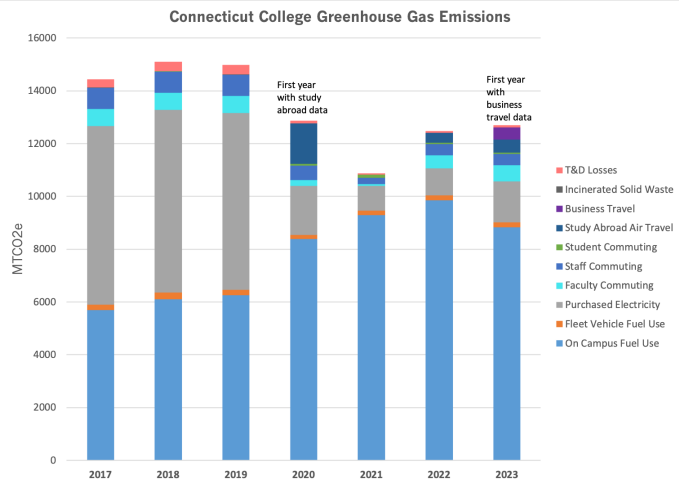Courtesy of Margaret Bounds
If you had to take a guess of which building on campus is carbon neutral, Crozier-Williams would most likely be last on your list. In 1999, Connecticut College partnered with Reforest the Tropics, an initiative that plants trees in Costa Rica to sequester carbon dioxide that would theoretically have been emitted from Crozier Williams. The project was funded by the College for $36,252 through former Botany Professor William Niering. With the planting of trees as a form of carbon offsets, Crozier Williams is a carbon neutral certified building.
However, the partnership is coming to an end at the end of 2024, which means that Crozier Williams will not be carbon-neutral for much longer. In a statement regarding the College’s pledge of carbon neutrality by 2030, “the College will be actively looking to adopt future forest offset projects in the future, possibly including an offset program utilizing the campus arboretum.” With the carbon neutrality goal six years away, this begs the question of, to what extent will this hold the College back on their promise, and is it possible for the College to pledge carbon neutrality without the dependence of carbon offsets?
The College Voice spoke with the Director of the Office of Sustainability, Margaret Bounds, about the future of carbon offsets at Connecticut College. When asked if there were any plans to purchase more offsets once the contract with Reforest the Tropics ends, she explained that there are currently no plans to renew the contract. The two reasons for this is one, the company has not been very communicative about renewing the contract. “We asked for a proposal two years ago and just haven’t heard from them,” said Bounds. The second reason is that the College doesn’t view offsets as suitable anymore. “We are now much more thoughtful about what it means to be utilizing space in another country for our own offsets,” explains Bounds. One example is being mindful of what trees are planted in Costa Rica. Bounds explained that the trees planted in Costa Rica are a species that sequesters carbon at a high rate, but is a non-native species to the area which raises concerns.
When asked how the College’s carbon emissions will look once the offsets expire, Bounds explained that Cro is currently offsetting 307 metric tons of carbon annually which is reduced from the annual campus emissions. In a 2017 report from Reforest the Tropics, the forests have captured and contain a total of 5,217 metric tons of carbon dioxide between 1999 and 2017. However, the College’s emission reporting is not directly tied to specific buildings, instead they are calculated for the entire campus community which means it will be hard to tell how much Cro contributes to the overall emissions once the offsets expire.
When asked about the 2030 Carbon Neutrality Plan and whether offsets will be necessary to reach the goal, Bounds explained that it’s hard to say where the College will be six years from now. “The reality is a lot of things take a long time to make a change in emissions. We are starting that process now, but we do have this period of uncertainty around 2030 and where we will be in the scheme of that.” In regard to offsets possibly being introduced again in the future, Bounds explained that “there will always be emissions that we can’t fully eliminate just by changing our infrastructure of campus.” For example, the Office of Sustainability can influence people to make changes, but people will continue to travel for study away, or continue driving to and around campus. Another example is the College’s current use of a fuel cell which provides 80% of electricity to the campus. Since the contract with the fuel cell doesn’t end until 2034, there is an option to use offsets for the four year period (2030-2034) before switching to a more sustainable option such as hydrogen fuel or wind/solar power in order to achieve net zero.
Overall, while the carbon offsets for Cro are soon coming to an end, there are still efforts on campus to reduce emissions and to promote sustainability. As of right now, Bounds shared that the College has actually reduced 17% of emissions since the reporting baseline year of 2017. Specifically in 2023, the highest emission source was on campus fuel use (the steam plant, fuel cell, other natural gasses…) at 70%. Purchased electricity is the second largest source at 12% and total commuting emissions is the third largest source at 9%. Despite the reduction of emissions since 2017, the College still has a long way to go before achieving a net zero campus by 2030. Whether or not this goal will be achieved, it is still important to be mindful of your own carbon footprint every day and to hold the College accountable for their own footprint in order to create true change.









